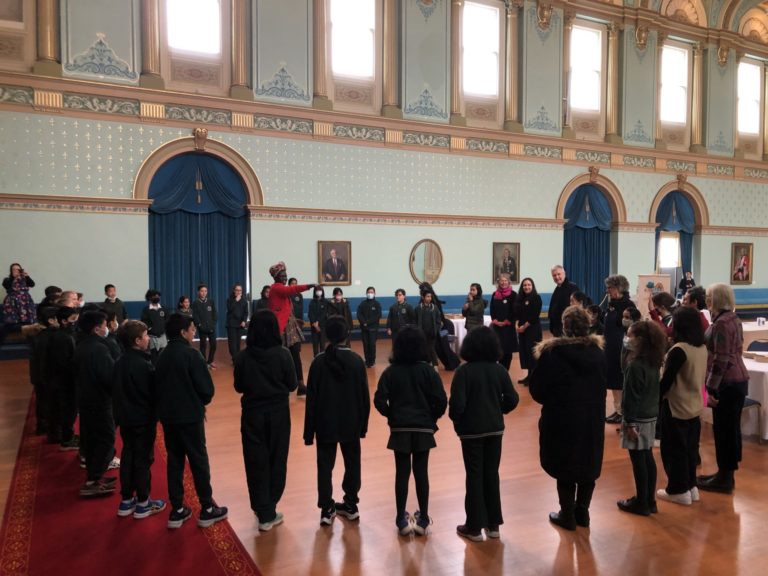A collaborative research project has revealed that an arts-rich approach to students’ writing enhances literacy skills and empowers children to express their unique voices.
It’s a finding that challenges the current focus on standardised testing and narrow metrics, by instead focusing on the different ways of knowing and being that students bring to their learning.
This research case study – undertaken by academics from the Australian Catholic University (ACU) and the University of Melbourne – highlights the transformative potential of creative and inspiring spaces in education and advocates for a more holistic approach to learning and literacy.
It underscores that an arts-rich environment serves as a bridge for students from diverse backgrounds to connect with their cultural knowledges and identities and express their experiences as writers.
Designing a positive learning environment
ACU Research Fellow Dr Mary Tomsic worked with the University of Melbourne’s Associate Professor Julie Choi and Dr Rafaela Cleeve Gerkens and says” it’s not only about enhancing literacy skills, but also supporting full participation, building confidence, validating children’s identities and expanding the ways they can express themselves in a way that creates a more inclusive and culturally aware learning environment”.
Currently, the often-narrow focus on the state of Australian students’ education and testing results means that opportunities to take a broader view of children’s self-expression, engagement, creativity, writing and literacy skills are missed.
Associate Professor Choi says a ‘back to basics’ approach is touted as a better way to improve students’ literacy outcomes nationally.
By adhering to a limited approach to the way writing is taught to Australian school students, the study found that there is a risk of dehumanising the writing experience, where narratives and persuasive texts become little more than formulas to be followed by young writers.
Although these genre-based understandings are essential and supportive for the development of young writers, Associate Professor Choi says the findings show that such teaching approaches – that aim to give children access to the types of texts they need for academic success – can sometimes ignore the many different ways of knowing and being that students bring to their learning.
Nurturing ‘meaning-making’ skills
Instead of viewing ‘struggling’ writers through a deficit lens, tapping into all the meaning-making skills that students bring to their learning can be positive.
“If we want to foster a society that embraces young people, their ideas and interpretations of their world and life, we need to take opportunities to listen to them and hear what they value and what they want to share,” says Dr Cleeve Gerkens.
“One way we can do this is by taking an expansive, inspiring, and active approach to writing in which a hands-on arts experiences take centre-stage.”
In the study’s research with multilingual children as writers, the findings show that tapping into their knowledge and identity – and providing opportunities to express themselves through creative arts activities – allowed children to begin and sustain their writing and express their unique voices as authors.
Creating books by children, for children – alongside artists
To complete their research, the trio of academics collaborated with the not-for-profit arts organisation Kids’ Own Publishing, which publishes books by children for children.
Year four students were invited to the Victoria’s Government House to tour the state rooms, view the diverse visual art collection on display and participate in an eight-page bookmaking workshop led by artists, which was held in the expansive grand ballroom.
Before making the books, the children were welcomed to the space through African drumming with storyteller AgumMaluach, and introduced to the work of the facilitating artists Bern Emmerichs and Ching Ching Liang.
It was a rich context that encouraged the participating children to explore the freedom to create their own books using collage materials and other art-making techniques.

Art informing art
Through the books students made, the conversations they had, and the way the students wrote about the experience afterwards, the researchers saw how allowing students to draw on all their meaning-making resources helped them to view themselves as capable, knowledgeable, and creative authors.
To highlight this, Associate Professor Choi uses the example of participating student Angelina, who realised she needed a main character for her story and drew on her knowledge of narrative structure to prompt her.
Her story’s protagonist was inspired by the fish-based artwork shared with the students by one of the facilitating artists, Ching Ching Liang.
Angelina also used the work of another artist present – Bern Emmerichs’ ceramic inspired scratch paper technique – to illustrate her character.
“A natural ocean setting presented itself through blue paper in various shades that was available on the table. With this inspiration, and in the interactive space where students were positioned around tables stocked with collage materials and black markers, Angelina engaged in free-flowing conversations with fellow students, teachers, and artists to develop her story,” says Associate Professor Choi.
“Angelina demonstrated her understanding of the role of dialogue in the narrative genre, drawing on the funds of knowledge of those around her (teachers, researchers, artists, and peers) to create a humorous tale of a fish learning words in many languages. Through this arts-rich bookmaking experience, Angelina’s authorly identity as a Multilingual Comedian emerged strongly.”
Celebrating proud family histories
In a very different book, another student, Jenny, wrote about her family history – and clearly relished the chance to share the story of her mother and grandparents’ migration with a wider audience.
“Before the workshop, Jenny had written an extensive narrative of her family’s migration journeys to Australia,” says Dr Tomsic.
“Through dialogue with a facilitating artist, Jenny used collage to select and highlight elements of her story by cutting and pasting them into her eight-page book and creating eye-catching illustrations of key elements of the story, such as the long boat crafted by her grandfather to look like a river boat to avoid suspicion during their escape.
“The opportunity to create a book in such an arts-rich space allowed Jenny to tell this very intimate story that was clearly important to her. Going public with her story enabled Jenny to proudly draw on her familial funds of knowledge, helping her to develop a unique authorial voice as we described as a ‘Grateful Family Historian’.”
As Jenny herself explained to the researchers, sharing stories like these helps deepen understanding of “how lucky [we] are and to be grateful for what [we] have”.
Written text in book: My Family History!
A day of danger: There was once a time in April 30th 1975, North Vietnam invaded the South part of Vietnam. They took property and moved my family with my mum’s side to the mountains and forests. It was dreadful. The peoples living in South Vietnam could not stay there. My grandpa secretly built a small boat carrying the whole family of 19 adults, including 2 pregnant women and 14 children. They left Vietnam at the end of October 1974. After 2 days and 3 nights of danger at sea they finally reached Kuala Dungan Malaysia in the middle of the third night. They stayed there for 7 months to do immigration paperwork to Australia. My Mum, Grandpa, Grandma and Auntie first arrived to Melbourne Australia on the afternoon of the first day of Winter June 1st 1979. My mum’s family is grateful to the Australian government for giving them a safe place to live.
Blurb: My family came to Australia on a day which will always be remembered by me. If you want to find out it is in this book.

Young writers are enriched by inspiring spaces
“As these examples show, when we open creative and inspiring spaces for young writers, they can demonstrate their skills in writing; their creativity; their funds of knowledge and identity and desire to write about themselves, their backgrounds and their lives,” says Dr Cleeve Gerkens.
“Such approaches can support children’s full participation, build confidence, validate their identities and expand the ways they can express themselves in a way that creates a more inclusive and culturally aware learning environment. Through our work with Kids’ Own Publishing, we can see the hugely supportive role that the community arts organisations can play in creating these opportunities for children to bring their local stories and knowledges into their writing in ways that build their voices and identities as authors.”








